A reformer is a device that produces pure hydrogen gas by reacting a methanol and water mixture. This mixture is standard industrial Methanol (IMPCA compliant) diluted with deionized water (ASTM type II) at ratio of 61.5% methanol, 38.5% by weight. Rather than referring to this as ‘diluted methanol’ our fuel goes under the friendlier name of “H2Go”.
First the reformer heats this mixture to vaporize the H2Go via an internal burner. The steam vapor then passes through a catalyst, where hydrogen molecules and some other components are separated, principally H2, CO and CO2. The hydrogen is then further purified by passing through a membrane, while the unused components are recycled back into the reformer. Additional H2Go is added together with air and the process is repeated, which increases both the reaction rate and the amount of hydrogen extracted.
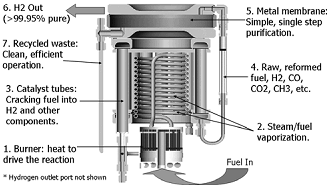 The temperatures that the burner operates at is typically at 480°C, the purifier slightly lower at 380°C and the best designed Reformers have a lot of intellectual property around the heat management i.e. keeping all the heat inside and it is quite common to hardly notice any heat radiating outside the reformer. Heat exhaust is normally past outside the reformer together with a very small amount of CO2. On the smaller 200W reformer fuel cell’s this CO2 is equivalent to the CO2 expelled from a child’s breath!
The temperatures that the burner operates at is typically at 480°C, the purifier slightly lower at 380°C and the best designed Reformers have a lot of intellectual property around the heat management i.e. keeping all the heat inside and it is quite common to hardly notice any heat radiating outside the reformer. Heat exhaust is normally past outside the reformer together with a very small amount of CO2. On the smaller 200W reformer fuel cell’s this CO2 is equivalent to the CO2 expelled from a child’s breath!
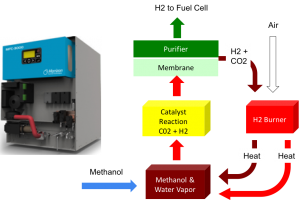
The production rate of the reformer is controlled by the Fuel Cell and can very quickly react to changing load conditions. Another aspect is that the consumption of the H2Go is linear and in most cases, as a rule of thumb, 1 Liter of H2Go, will provide 1kW hour of power.
An integrated Methanol Reformer Fuel Cell (MRFC) typically contains three components, a Reformer, a Fuel cell (with integrated DCDC power controller) and a fuel tank.

The design is typically based on a standard telecom cabinet, rated at IP45, which measures 2m high by 0.7m wide by 1m deep. The cabinet design in effect determines the size of fuel tank that can be included however this system, called an MFC3000, which supports a 3kW load has a 200 Liter tank so in effect offers 200 hours of autonomy. This is in a foot print less than 1m2, which is incredibly attractive for the telecom market where renting space on tower site can be costly.
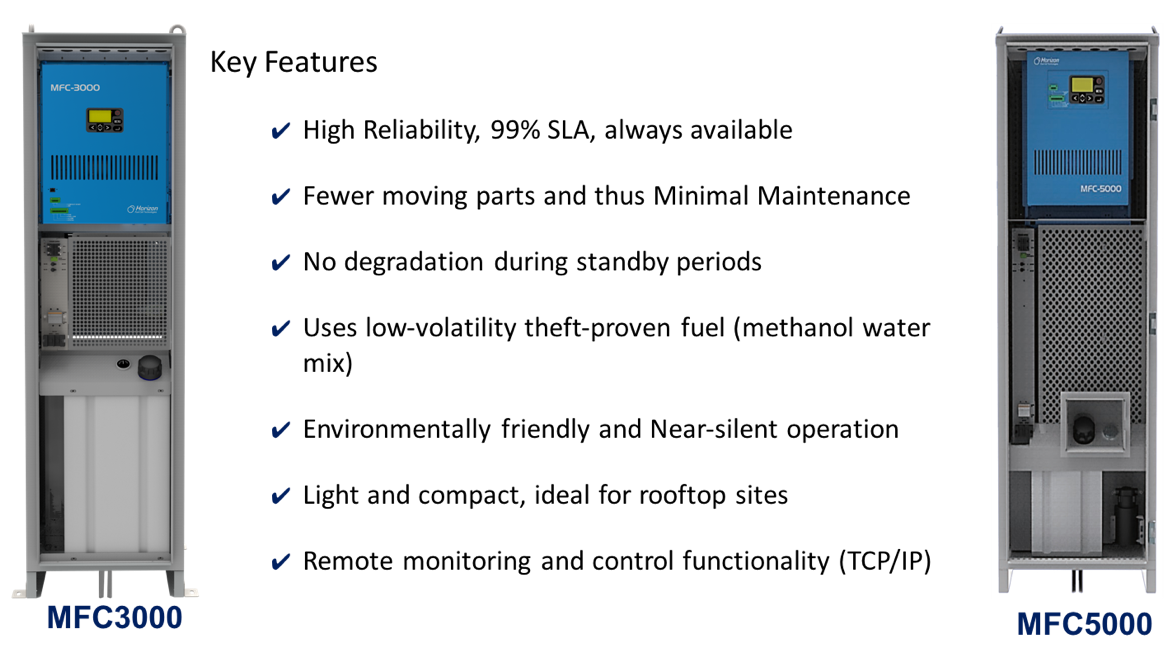 The same cabinet design can also be used to house a second fuel cell stack to provide a total power output of 5kW. In this case, the fuel tank size is reduced to accommodate this and results in a tank size of 100 L which supports autonomy of 100kW hours.
The same cabinet design can also be used to house a second fuel cell stack to provide a total power output of 5kW. In this case, the fuel tank size is reduced to accommodate this and results in a tank size of 100 L which supports autonomy of 100kW hours.
Increasing the autonomy is relatively straight forward. Both systems come with an external fuel pump as standard, so it is simply a case of adding an additional tank and connecting this to the external fuel pump using a 4mm plastic hose. Only one fuel line is needed as there is no need for a fuel return line.
The external fuel pump can be remotely activated and the onboard controller automatically transfers fuel from the external tank to the internal tank once the internal tank fuel level reaches 30%.
 The preferred fuel store for H2Go is a commonly available IBC (International Bulk Container) tank. These IBC’s consist of a metal frame surrounding a blow-moulded inner cube and are mounted on the pallet. Containers should be UN approved and fully stackable. IBC’s are also available with a wood or metal pallet.
The preferred fuel store for H2Go is a commonly available IBC (International Bulk Container) tank. These IBC’s consist of a metal frame surrounding a blow-moulded inner cube and are mounted on the pallet. Containers should be UN approved and fully stackable. IBC’s are also available with a wood or metal pallet.
A standard IBC tank can typically contain 1,000 L of H2Go which can increase the system autonomy to 1,000kW hours in addition to the 200 kW hours in the internal tank of the MFC3000 and 100kW hours of the MFC5000. An IBC tank footprint typically is 1m2 so this takes up relatively little space.
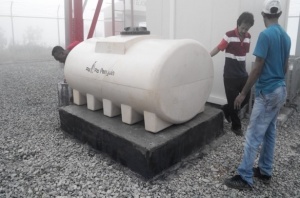 If that is not enough, you can also locally source a 2,000 Liter water tank, as used in Timor Leste.
If that is not enough, you can also locally source a 2,000 Liter water tank, as used in Timor Leste.
This provides a whopping 2,000kW hours of autonomy. To put this into perspective, with this amount of fuel an MFC3000 running at full load will run for 733 hours (30.5 days) and the MFC5000 will run for 420 hours (17.5 days) …. at full load.
The foot-print of the 2,000L tank is approximately 2 square meters.
The MRFC is designed to use “H2Go” which is a blended mix of methanol and water). Methanol is an ideal source of hydrogen for fuel cells. As a fuel, methanol (CH3OH) offers significant advantages over other hydrocarbons such as natural gas, propane and gasoline. Among these are its freeze tolerance, biodegradability, consistent high quality, and lower reforming temperature. It is widely distributed, cost-competitive, and already found in a range of products such as windshield washer fluid and household solvents, methanol is a reliable fuel with a bright future.
As one of the worlds most widely distributed chemical feed-stocks, methanol is a consistently high quality fuel that meets strict industry specifications. Compared to competing fuels it has a very low sulfur content (a maximum of 0.5 ppm) which simplifies the reforming process. It reduces the capital, operating and maintenance costs of the fuel cell system and greatly reduces the risk of fuel cell damage. Methanol is locally produced and in many countries in SEA, I already have in place the production and logistics network to locally produce H2Go and therefore take full responsibility for the refueling process.
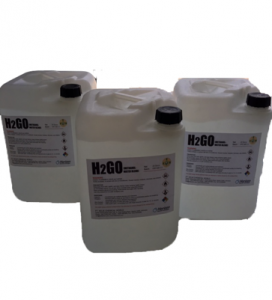
The cost varies, depending on country and volume however, in SEA we have managed to price this at anywhere between 0.32 – 0.50 USD cents per litre. Since our fuel consumption is ‘linear’ this can be translated to the actual price per kW hour.
In many countries, our target is to set the H2Go cost to be about 80% of the equivalent price of diesel, to make this attractive to the customer as in addition to being cheaper than diesel, the actual volume of fuel needed is less than using an equivalent diesel GenSet.
Unlike diesel, the Methanol market price is generally static, so there is little chance of variances in cost over time, due to market conditions, which is a recurring problem with diesel. So far, the cost per Litre of H2Go is varies around 0.35 cents in Indonesia/Philippines to 0.50 cents in Myanmar.
What is also a hidden benefit, is the transportation is much easier than diesel, as H2Go being a dilute version of Methanol, means it is safe to transport this in plastic containers. I use Uber/Grab-Taxi to deliver H2Go in metro Manila and Jakarta ;-).
Finally, Methanol is generally available locally so you are not only restricted to one source for H2Go. We will show you how to make this yourself or indeed any Methanol distributor will generally be happy to do the blending for you also.
There are indeed smaller integrated reformer fuel cell systems in the range of 100W and 200W. These are primarily supplied to integrators who develop the balance of plant around their application requirements. Existing deployments include providing power for IP cameras, water level sensors, SCADA and telemetry systems, surveillance and even as a wireless charger for autonomous drones.
 Methanol Reformer Fuel Cell, Conclusion
Methanol Reformer Fuel Cell, ConclusionThe MFC3000/MFC5000 with a foot-print of less than 1m2 offers immediate savings in space, weight, regulatory setbacks such as clear-space requirements, simplified refueling, and enables much longer and extended run times over traditional solutions. For critical telecom infrastructure network backup power applications, this technology offers several advantages:
Easy Fueling: Customers can enjoy the benefits of fuel cell technology – reliable, quiet, and environmentally friendly – without the challenges of hydrogen delivery, installation, and storage. I fully manage all aspects of the fueling process.
Long Run Times: The MRFC system can power a site for several days without refueling while a fuel cell system that runs on compressed hydrogen typically can power a 5 kW for several hours only. Further, with our monitoring service 24 * 7 continuous runtime with ongoing refueling is possible.
Remote Location Deployments: Fuel cell systems are now commercially deployed in regions where access to hydrogen is not available by generating on-site on demand from readily available fuels.
Small footprint and lightweight: The MRFC system with its included 200L internal fuel tank offers a solution which is much more compact and lighter weight than batteries or diesel generator systems, enabling installation on rooftops, mezzanines, and other constrained sites.